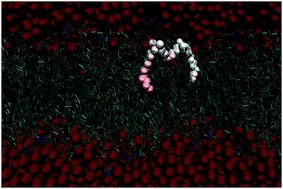Gemini surfactants possess interesting interfacial and aggregation properties that have prompted comprehensive studies and successful applications in a wide variety of fields. However, a systematic study on the effect of gemini tail and spacer length upon the organization of lipid membranes has not been presented so far.
In this study, we analyze the action of dicationic alkylammonium bromide gemini surfactants on DPPC liposomes, the latter employed as a model of lipid membranes. Differential scanning calorimetry results indicate that the surfactants presenting shorter tails (12 carbons) induce a decrease in the overall order of the bilayer, while those with longer tails (16 and 18 carbons) lead to the formation of more ordered structures. The respective influence on the degree of lipid order transverse to the bilayer was additionally studied resorting to a detailed fluorescence anisotropy study. In this case, it is observed that among the shorter tail surfactants, those with longer spacers (6 and 10 carbons) are responsible for a more pronounced disrupting effect upon the membrane, especially close to the lipid polar heads.
Molecular dynamics simulation supports the most important findings and provides insight into the mechanism that governs this interaction. Accordingly, the interplay between tail and spacer length accounts for the differential vertical positioning of the gemini molecules and atom-density in the core of the bilayer, that provide a rationale for the experimental observations.


 Please wait while we load your content...
Please wait while we load your content...